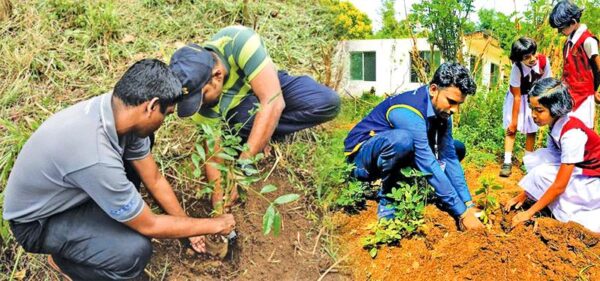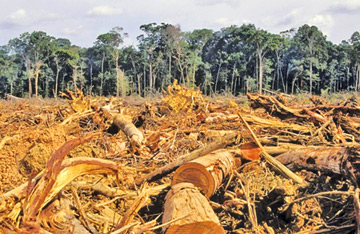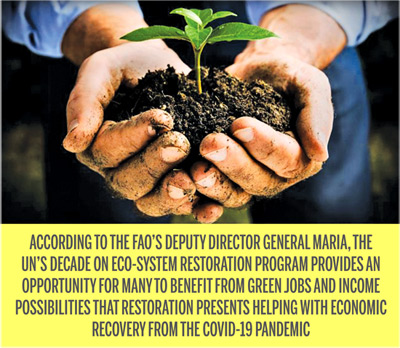International Day of Forests tomorrow Healthy forests mean healthy people – by NIMAL WIJESINGHE

Source:sundayobserver.lk
The United Nations General Assembly proclaimed March 21 International Day of forests in 2012 and since then, the world communities have been celebrating and raising awareness of the importance of forest. United Nations initiatives have encouraged countries to undertake local, national and international efforts and endeavors to organize activities involving forests and trees such as tree planting campaigns.
 Last year, International Day of Forests was marked under the theme “Forest Restoration: A path to recovery and wellbeing”. Forest conservation and restoration are priority areas for mitigating the effects of climate change. The country is endowed with a diverse range of forests. Mountain forests, riverine dry forests, Savana and mangrove forests are among the major types of forests in Sri Lanka. Conservation of environment is enshrined in the Constitution of Sri Lanka. The State has pledged to protect, preserve and improve the endowment for the benefit for the people
Last year, International Day of Forests was marked under the theme “Forest Restoration: A path to recovery and wellbeing”. Forest conservation and restoration are priority areas for mitigating the effects of climate change. The country is endowed with a diverse range of forests. Mountain forests, riverine dry forests, Savana and mangrove forests are among the major types of forests in Sri Lanka. Conservation of environment is enshrined in the Constitution of Sri Lanka. The State has pledged to protect, preserve and improve the endowment for the benefit for the people
 However, reports indicate an increase in deforestation and degradation of the forest cover in Sri Lanka. The forest cover as at 2017 was 29.7 percent. In the 1920s, the island had a 49 percent forest cover, but by 2005, this had dropped to 26 percent. It was found that between 1990 and 2000, Sri Lanka had lost an average of 26,800 hectares of forest per year. This amounts to an average annual deforestation rate of 1.14 percent. Between 2000 and 2005, the rate accelerated to 1.43 percent per annum. Figures by the Food and Agricultural Organization (FAO) have suggested that in 2020, the country’s forest cover had further reduced to 28.39 percent (1.86 million hectares) of the land area.
However, reports indicate an increase in deforestation and degradation of the forest cover in Sri Lanka. The forest cover as at 2017 was 29.7 percent. In the 1920s, the island had a 49 percent forest cover, but by 2005, this had dropped to 26 percent. It was found that between 1990 and 2000, Sri Lanka had lost an average of 26,800 hectares of forest per year. This amounts to an average annual deforestation rate of 1.14 percent. Between 2000 and 2005, the rate accelerated to 1.43 percent per annum. Figures by the Food and Agricultural Organization (FAO) have suggested that in 2020, the country’s forest cover had further reduced to 28.39 percent (1.86 million hectares) of the land area.
Change in forest area
However, an estimated 3.16 percent change in forest area had been observed during 2015-2020 whereas primary forests were the most affected forest types. In 1999, the country comprised 257,000 hectares of primary forests whereas after two decades, it was only 167,000 hectares.
Many of us have relied on essential forest products such as paper and cardboard including personal protective equipment and packing for home deliveries. For others, forests have offered a space to boost health and spirit. But for vulnerable people around the world, forests have been acting as vital safety nets providing food sources and income when supply chains are disrupted.
This is in addition to the extraordinary benefits forests provide such as acting as carbon sinks, purifying water, supplying food, fuel and medicinal plants catering to well over billion people and supporting the livelihoods of hundreds of millions more. Climate change is one of the most serious issues faced by the world at present. Excessive use of petroleum resources for energy generation has greatly attributed to this through the release of carbon dioxide which is one of the gases responsible for the global climate change, referred to as Green House Gases (GHG).
There has been a high global attention on reducing GHG emission in various development processes. Since 1990, the world led by the United Nations has made efforts to combat the situation through the United Nations Framework Convention on Climate Change in view of the deminishing forest cover.
According to the Food and Agriculture organization (FAO), forests are home to about 80 percent of the world’s terrestrial biodiversity with more than 60,000 tress species. Around 1.6 people depend directly on forests for food, shelter, energy, medicines and livelihood empowerment.
Land degradation
The world is losing 10 million hectares of forests annually which is about the size of Iceland. Land degradation affects almost two billion hectares – an area larger than South America. Spending time around trees helps boost our immune system, lowers blood pressure and promotes relaxation. Many of the medicines we rely on come from forest resources. Around 25 percent of medicinal drugs used in developed countries are plant based, while in developing countries it can be 80 percent. It is estimated that some two billion hectares of degraded land worldwide have the potential to be revived. That is roughly twice the size of Europe.
Some diseases originate from the transfer of pathogens from animal to humans. They usually occur when the natural landscapes mainly such as forests are being cleared. As such healthy forests mean healthy people. Covid-19 has served as a wake-up call to the fact that the health of people, animals and environment are inter connected.
Large scale development projects and many other forests based activities carried out over a long period have resulted in the eradication of many picturesque forests.
During the British rule, forests were cleared for cultivation and timber was procured largely for government purposes from throughout the country. During the colonial period under the Portuguese, Dutch, there had been a considerable exploitation of prized timber such as Nedun for export to the Europe, while the forest destructing Chena cultivation began to proliferate in the dry zone of Sri Lanka.
Later when the British rulers realised that deforestation needed to be done away with or strictly controlled, forest officers were appointed under the Government Agents in the 1870s. The Forest Department was established in 1887 with the appointment of a forest conservator.
Legislation
The law applicable to the Forest Department is the forest ordinance which was passed in 1907 and still in force and followed. However, it was not until 1995 that a National Forest Sector Policy was adopted to conserve forests for the benefit of future generations.
People encroach into protected areas for agricultural and mining activities. With the growth of population, the demand for land and field crops and agriculture products is on the increase. Hence people who are pressurised by these drivers encroach into protected areas. On the other hand, adhering to the government policies from time to time to increase local agricultural production and controlling the agricultural imports such as sugar and milk lead to an expansion of agriculture ventures. Various infrastructural development projects are another driver of deforestation and degradation of forests.
Incoherent attitude in policies on forest conservation along with new initiatives to expand agricultural production can encourage encroachments and consequently deforestation.
It is appreciative that the government affiliated ecosystem conservation and management project has initiated a pilot landscape management planning process with the assistance of the World Bank. Two areas have been selected for this pilot project to be implemented in the dry zone and the wet zone of Sri Lanka.
Planning methodology
This type of landscape based planning methodology focuses on natural resources and human activities and manages multiple land use patterns under a combined plan to prevent or minimise forest land degradation and unwarranted destruction. In the World Bank funded pilot project, the earmarked areas are the Hurulu – Kawdulla – Kantale landscape and the Sinhajara landscape.
The project area of the dry zone’s Hurulu – Kawudulla – Kanthale landscape is around 528,826 hectares which included forest reservations such as Hurulu Konwewa, Rathmale, Moragaswewa, Padaviya, Kantale, Chundankadu, Thanaparichchan, Pamburugashinna and Anavilundawa in 14 Divisional Secretariat areas in the Anuradhapura, Polonnaruwa and Trincomalee districts. The other landscape area under the pilot project is Sinharaja forest reservation consisting of 242,695 hectares, of this 150,473 hectares are forests including protected areas.

The Sinharaja world heritage site covers forest reserves namely Morapitiya Rana Kanda, Muwagan Kanda, Handawal Kanda, Mudali Kanda, Yakkanda, Nawkanda, Kabaragala, Walankanda, KalugalaSooriya Kanda, Kalubowitiyana and Diyadawa. The landscape plan comprises 16 Divisional Secretariat jurisdictions in Ratnapura, Galle, Mathara and Kalutara districts.
Deputy Director General of the Food and Agriculture Organization of the United Nations Maria Helena Semedo said never before has there been greater reason to focus world attention on the precious natural resources mainly the forests which cover a third of the earth’s land area.
“First we need to halt practices that drive large scale conversions of forests for agriculture, recognising that it is possible to feed the growing global population without cutting down forests. Second, we must crack down on the illegal wildlife trade while respecting that wildlife remain an essential source of food and income for millions of indigenous people and communities.
“Third, we need to invest in restoring the world’ degraded forests and landscapes to re- establish healthy eco-systems. Around two billion hectares, an area twice the size of China are degraded due to overuse, drought and unsustainable forest and land management practices in countries. The good news is that we can restore degraded land on a large scale. The great Green Wall for Sahara and the Sahel initiative led by the African Union is an example.
“By 2030, it aims to restore 100 million hectares across Africa’s dry lands with local tree species and vegetation greening landscapes while sequestering 250 million tonnes of carbon and creating 10 million green jobs,” the UN’s FAO Deputy Director General said.
According to the UN’s FAO, more than 60 countries and entities have committed to restoring over 210 million hectares of degraded land similar to an area almost two thirds of the size of India. Globally, ambitious targets have already been set: the Bonn Challenge calls for the restoration of 350 million hectares by 2030.
Eco-System Restoration
The United Nations Decade on Eco-System Restoration began last year and is an opportunity to upscale forest restoration across hundreds of millions of hectares healing degraded lands. According to the FAO’s Deputy Director General Maria, the UN’s Decade on Eco-System Restoration program provides an opportunity for many to benefit from green jobs and income possibilities that restoration presents helping with economic recovery from the Covid-19 pandemic.
In Sri Lanka, apart from environmental implications, deforestation has caused flooding landslides and soil erosion from exposure of the deforested areas. The Government and international environmental organisations have taken steps to address the problem over the years, establishing national parks, reserves and sanctuaries which now cover 15 percent of the island’s total area. The Sinharaja forest reserve established in 1978 to protect the nearly extinct lowland rain forest was flagged as a world heritage site in 1988.
Referring to the country’s environmental problems, Environment Minister Mahinda Amaraweera said that a tree planting program based on 103 major river banks has been launched to plant two million saplings such as Kumbuk, Mee, Atamba, Kaluwara, Burutha, Ingini, Wewarana, Halmilla and Kolon.







